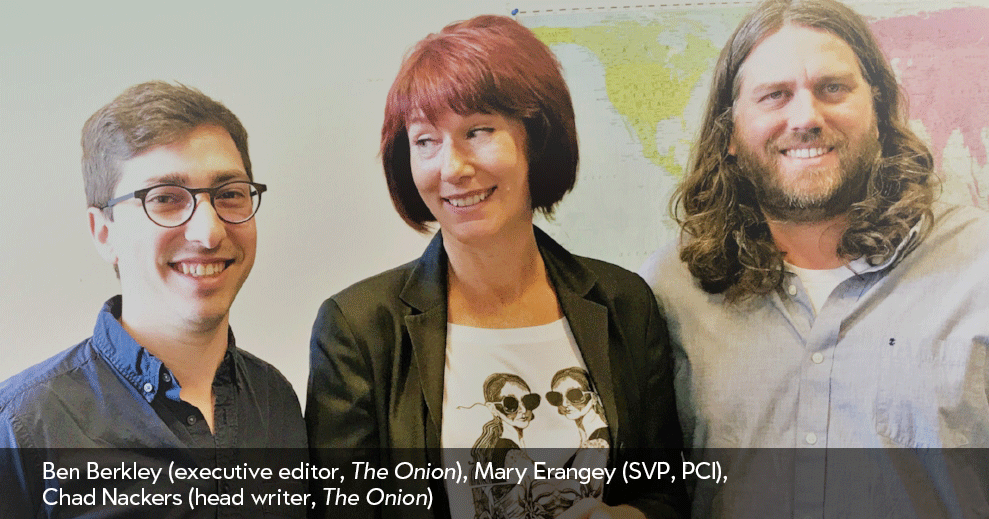
Discerning fact from fiction…and what it has to do with satire

Mary Erangey
Senior Vice President
In 2012, the official Chinese People’s Daily English language website ran a story about North Korea’s Supreme Leader Kim Jong-Un being named the sexiest man alive. The site took the story from another publication and ran it word-for-word. That publication was The Onion.
Language barriers and cultural differences in humor no doubt contributed to the spoof being mistaken for real news. But five years later it’s become increasingly difficult for any of us to discern fact from fiction. Is the story true? Is it satire? Is it fake news?
To be successful, satire depends on two things:
- Reality-based information (otherwise jokes don’t work; what’s true is what’s funny)
- An informed audience (otherwise no one gets the joke)
That’s why The News Literacy Project (NLP) recently gathered satirists, journalists and communication professionals to talk about satire and news literacy. I was one of the lucky PR professionals to be there to hear Peter Sagal of National Public Radio’s “Wait Wait… Don’t Tell Me!” (which features a game called “Bluff the Listener”—to win, the listener must pick the true news story from three seemingly unbelievable stories) and Chad Nackers and Ben Berkley of The Onion.
Every one of us in the room had a stake in solving that problem.
And so do you, if you represent the communication interests of organizations, institutions or brands.
Why?
Because we all live in a world where information is currency. And while there are wagonloads of it around these days, sifting through the heaps to find what’s true gets harder and harder to do.
In the 24/7 churn of real-time news, social media and the bubble of politically motivated fake news stories, your brand reputation may depend on consumers having the critical thinking skills to sort the real from the fake.
In a February 2017 Associated Press article, Andy Borowitz of The New Yorker magazine’s “The Borowitz Report” said “the fact that so many Americans have to go to Snopes.com to find out that Trump didn’t really hire El Chapo to be head of the D.E.A. or something like that, that’s a reading comprehension problem.”
Nackers – the comedic brain behind The Onion’s long-running series about Vice President Joe Biden – says in the world of satire, the absence of reality-based information and an informed audience can lead to bizarre situations, such as the unlikely honor bestowed upon Kim Jong-Il.
So how can a satirist or communications professional avoid getting pulled into the churn?
- Stay curious. Be interested enough to dig further than the headlines, photo captions and call-out quotes. Use online tools to help you vet information: Snopes.com, RealorSatire.com or Politifact.com.
- Rethink how you monitor media to stay on top of trends. Media monitoring and analysis are more important than ever to help organizations, institutions and businesses have a clear sense of relevant conversations happening on all forms of digital media. Consider whether you need to broaden your search criteria to ensure you’re informed on issues and trends beyond simple mentions of your brand, organization, institution or company. You may need to cast a wider net. And you probably need to invest in analysis; it’s insight you need, not just lists of media coverage.
- Advocate for news literacy. If you’re in the business of informing audiences – like journalists and professional communicators – you have to help cultivate audiences who are willing to scrutinize information. That’s where NLP comes in, with digital tools, training and curricula to help teachers and students across the country dig deeper, learn to think like journalists, ask tough questions, uncover sources and discern intentions behind news information. Find out if your area middle school or high school offers news literacy instruction. If they don’t, tell your local teachers, principals and superintendents to check out NLP.
None of these are quick fixes.
But nothing worthwhile is easy.
The Onion staffers write and pitch 1,500 headlines each week. Through an exhaustive, relentless process, they scrutinize and whittle them down until they have 30 or 40 that bear The Onion’s stamp of originality.
That willingness to invest so much time and effort is why we can always count on them to make us laugh.


